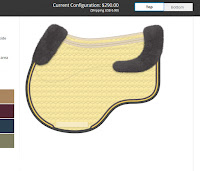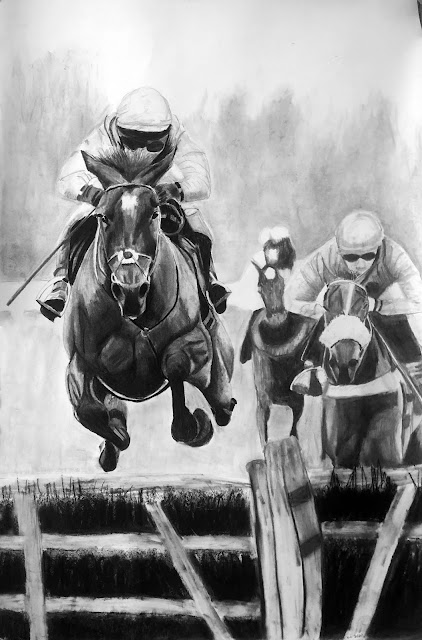Last weekend I had a scare. When I was outside feeding the horses in the evening, Raven was standing at the gate, which in itself isn't too unusual. The odd part was how agitated she was. She happily ate her mash, but when she finished she began pawing, kicking, staring at her belly, and then proceeded to lie down and get up repeatedly in the alley between the barn and the water tanks, a high traffic area where she was sure to be noticed.
I brought her back into the barn, checked all her vital signs, and discovered that she was feeling painful and had a belly ache, or colic. I gave her a dose of equine pain medication, contacted my veterinarian Dr. Landes with Equine Medical Services, and passed on to him all her vitals and how she was presenting. I gave her an hour to see if the pain meds I'd administered would have an effect, but unfortunately they didn't seem to make her any more comfortable. By then it was dark and cold, as we were in the midst of a polar freeze plummeting the temperatures down to negative double digits, and it was snowing. Dr. Landes headed out to our facility in the dark snowstorm.

In the forty minutes it took for him to arrive from his place, Raven became progressively more painful. I began walking her in a large circle outside the barn in our parking area which was just barely lit by the barn lights reflecting off the snow. If I wasn't actively distracting her she would throw herself on the ground and begin thrashing regardless of whether she was in the stall, barn aisle, or outside in the snow. I didn't want her to injure herself in this violent behavior, so I kept telling her I heard her complaints, but that we needed to keep moving as walking was safer than flailing.
Generally with a mild colic I let the horse lie down, as pressure from the ground on the belly will often help with pain relief. However, when Raven was not merely lying quietly but thrashing in pain to the point of injury I couldn't let her roll like that. We were still walking when Dr. Landes arrived, and we all went into the barn where he tried to take her temperature. As soon as she was standing in the barn she tried to collapse and go down, so instead of taking her temperature Dr. Landes gave her some IV pain meds and sedative. Once she was standing quietly under the influence he resumed his examination.
She had no gut sounds on auscultation (listening with the stethoscope), which was different than an hour previously when I'd appreciated very loud rumblings coming from her abdomen. Because she was in so much pain Dr. Landes gloved up to his armpit to do a rectal exam, my computer programmer husband looking on appreciating his tech job more all the time. Thankfully there was nothing amiss internally that Dr. Landes could tell. Her spleen was in the right place and was a normal size, her manure looked normal, there were some fecal balls in her small intestine, there was no twist in the intestines that could be felt. It didn't explain why she was acting this way, but it was good news that nothing catastrophic was obvious.
Dr. Landes then proceeded to place a nasogastric tube (a tube that goes up the horse's nose, through the esophagus, and down into the stomach) and gave her some mineral oil and water. The hope was that she would gain some hydration that way and I could watch for the mineral oil to appear in her manure to demonstrate that the biological plumbing was working all the way through. I put her in the stall in the barn in some deeply bedded shavings with warm water buckets so that I could monitor her better. We did everything we could for her in a snowy barn at night, and then it became a waiting game to see if she would feel less painful once the sedation wore off. If the pain broke through the medications and sedative we would have had to consider hospitalization, surgery, euthanasia, all the difficult and expensive decisions.
For the next several hours through the night I went out to check on her and made detailed notes on her stance (up/down), whether she had drunk any water, whether she had passed manure and what it looked like (color/consistency/shape/mucus/mineral oil), heart rate, temperature, respiratory rate, mucus membranes, and capillary refill time. She did lie down over the next few hours, but it was quiet resting not the agitated thrashing I'd seen earlier in the evening. Finally at eleven pm I sent Dr. Landes the last text of the night saying she was looking much better and we could each go to sleep since I wouldn't need him to come out again that night. My husband checked her once more just after midnight and she still looked ok, so he eventually came to bed too.
The following day Raven was bright eyed and eager for morning mash. I gave her the regular amount of mash, but I made it extra soupy to get more warm water into her in case this had been a dehydration colic. She happily slurped it up, sounding just like a toilet being plunged. She'd passed normal manure overnight, had been happily eating at her hay bag, and had drunk a few gallons of water. Still no idea what had caused her to colic, but sometimes you don't get the answers. I kept her in the stall for the rest of the day and that night, just to be able to continue monitoring her more carefully than if she had been out in the big paddock with the other horses. Sunday morning she still looked like herself, feisty with sassypants, so I let her go back out to her usual living accommodations.
As a result, I've been feeling quite thankful for my situation. I'm so grateful to have a barn with lights where we could treat her at night in a snowstorm. I'm grateful for Dr. Landes' willingness to come treat her when we all know it would have been nicer to stay home on the couch in such bitter cold weather. I'm grateful for my husband checking on her one last time before bed for my peace of mind, as well as coming outside to keep me company as I walked her in the parking area in the snow. Mostly, I'm grateful for Raven. Getting so close to the hard decisions makes me reflect on my time with her, and how much I appreciate her being in my life. A huge blessing to me was the day Feisty McSassypants became my mare.
I came across a short essay online from Legacy Sporthorses Facebook page this afternoon that I edited to suit my own relationship with Raven. Here it is:
There is an unfortunate trend going on in the world of
horses (and rescue) that I see all too often. Having unrealistic expectations
from our equine partners and seeking "the perfect horse".
The reality is, there truly isn't a "perfect"
horse. Every single horse you meet will have his own set of quirks and
personality traits that makes him, well, HIM. From barn presence, to
behavior faults, each one is unique. As owners, our job is find a horse with
such characteristics that suit us. When horse
shopping I tell people that every horse has baggage, just like every
rider. You have to find the horse whose
baggage color-coordinates with yours.

People who know her well though, would say she has all the
quirks and triggers I find most endearing and not everyone would like the type
of quirks she has.
She insists I ride correctly, or she will buck or rear in
disgust. She gets excited and nervous about going places and will get herself
pretty worked up if she doesn't have enough warmup, or has too long a warmup before
competing. She is like riding a race car both in the arena and on the trail,
small, sporty, and quick-maneuvering. If
you watch her when tied at the trailer, she'll fling poop at you as she swings
her hind feet in impatience before a ride. She insists on correctly fitting tack, every piece
of it from bit (or hackamore) to hind boots and everything in between.

These are the things that, albeit annoy me some days, are my
favorite things about her because it's what makes her Raven in all of her
antics. She’s as smart as the ravens who live in our indoor arena, in a giant nest
that they add onto every year, and who have learned to mimic all the sounds
regularly heard around here. These birds
click, kiss, bark, whine, and I swear I’ve heard them say my name. Those birds are brilliant, and so is my
Raven. No horse is perfect but Raven is
perfect for me.
If you want the perfect horse, get a four-wheeler that doesn’t
make its own decisions. Just remember that next time you're looking for your
next partner, to find the horse with quirks that are fun for you, and whose
baggage color coordinates with yours.

























